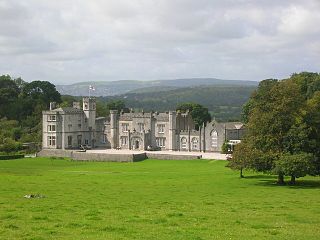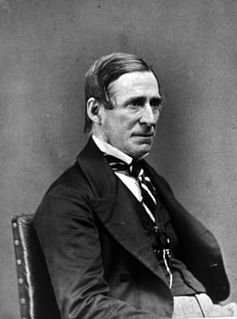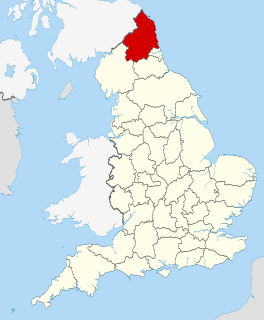
Viscount Ridley is a title in the Peerage of the United Kingdom. It was created in 1900 for the Conservative politician Sir Matthew White Ridley, 5th Baronet, Home Secretary from 1895 to 1900. He was made Baron Wensleydale, of Blagdon and Blyth in the County of Northumberland, at the same time, also in the Peerage of the United Kingdom. The latter title was a revival of the barony held by his maternal grandfather James Parke, Baron Wensleydale, whose title became extinct upon his death since none of his sons survived him.

Baron Denman, of Dovedale in the County of Derby, is a title in the Peerage of the United Kingdom. It was created in 1834 for the prominent lawyer, judge and Whig politician Thomas Denman. He served as Lord Chief Justice of the King's Bench from 1832 to 1850. His son, the second Baron, assumed in 1876 by royal licence the additional surname of Aitchison, which was that of his father-in-law. He was succeeded by his grandnephew, the third Baron. He was the grandson of the Hon. Richard Denman, younger son of the first Baron. Lord Denman notably served as Governor-General of Australia from 1911 to 1914. He was succeeded by his eldest son, the fourth Baron. On his death in 1971, the title passed to his first cousin, Sir Charles Denman, 2nd Baronet, of Staffield, who became the fifth holder of the title.
Baron Northbourne, of Betteshanger in the County of Kent, is a title in the Peerage of the United Kingdom. It was created in 1884 for Sir Walter James, 2nd Baronet, who had earlier represented Hull in the House of Commons as a Conservative. His son, the second Baron, sat as a Liberal Member of Parliament for Gateshead. As of 2018 the titles are held by the latter's great-grandson, the fifth Baron, who succeeded his father in 1982. Lord Northbourne was one of the ninety elected hereditary peers that were allowed to remain in the House of Lords after the passing of the House of Lords Act 1999, and sat as a cross-bencher until his retirement in 2018.

There have been three baronetcies created for members of the Grey family, one in the Baronetage of England, one in the Baronetage of Great Britain and one in the Baronetage of the United Kingdom. Two of the creations are extant as of 2007.
The Stanley, later Stanley-Massey-Stanley, later Errington Baronetcy, of Hooton in the County of Chester, was created in the Baronetage of England on 17 June 1661 for William Stanley, the great-grandson of Sir William Stanley, of Hooton and Stourton, a member of the Stanley family headed by the Earl of Derby. The sixth Baronet assumed the surname Stanley-Massey-Stanley. The ninth Baronet married Mary Haggerston, great-niece and heiress of Henry Errington of Sandhoe House, Northumberland. Their eldest son, the tenth Baronet, represented Pontefract in Parliament. Their second son, Rowland Stanley, the eleventh Baronet, inherited the Errington estate in Northumberland and changed his name to Errington. The title became extinct on the death of the twelfth Baronet in 1893.

There have been two baronetcies created for members of the Trevelyan family, one in the Baronetage of England and one in the Baronetage of the United Kingdom. As of 2014, both creations are extant.
There have been two baronetcies created for members of the Blackett family, both in the Baronetage of England. One creation is extant as of 2013. The Blackett family can be traced back to the Blacketts/Blakheveds of Woodcroft, County Durham, some of whom became highly successful in the lead and coal mining industries in Northumberland and County Durham.

There have been six baronetcies created for persons with the surname Middleton, four in the Baronetage of England, one in the Baronetage of Great Britain and one in the Baronetage of the United Kingdom. One creation is extant as of 2008.
There have been four baronetcies for persons with the surname Blake, one in the Baronetage of Ireland, two in the Baronetage of Great Britain and one in the Baronetage of the United Kingdom. Two of the creations are extant as of 2010. The Blake Baronetcy, of Menlough in the County of Galway, was created in the Baronetage of Ireland on 10 July 1622 for Valentine Blake, Mayor of Galway in 1611 and 1630 and a member of the Irish House of Commons for Galway. His grandfather Thomas Blake had preceded him as Mayor. The second Baronet was a member of the Irish Parliament for Galway Borough. The third Baronet represented both County Galway and Galway Borough in Parliament. The sixth Baronet was a member of the Irish House of Commons for County Galway. He was the first Catholic gentlemen of distinction to join William of Orange. The twelfth Baronet represented Galway Borough in the British House of Commons. The fourteenth Baronet was High Sheriff of County Galway in 1872. See also the Blake Baronetcy of Twizell Castle below.
There have been two baronetcies created for persons with the surname Renwick, both in the Baronetage of the United Kingdom.
There have been three baronetcies created for persons with the surname Noble, all in the Baronetage of the United Kingdom.
The Milburn Baronetcy, of Guyzance in the Parish of Shilbottle in the County of Northumberland, is a title in the Baronetage of the United Kingdom. It was created on 30 December 1905 for John Milburn. He was High Sheriff of Northumberland in 1905. The Milburn family had made their fortune in shipping and coal. The third Baronet served as High Sheriff of Northumberland in 1928.
There have been five baronetcies created for persons with the surname Ward, one in the Baronetage of England, one in the Baronetage of Ireland and three in the Baronetage of the United Kingdom. See also Warde baronets.

There have been three baronetcies created for persons with the surname Paget, all in the Baronetage of the United Kingdom, and a fourth created for the Bayly, which later became the Paget Baronetcy. As of 2016, two of the creations are extant.
There have been two baronetcies created for persons with the surname Simeon, one in the Baronetage of England and one in the Baronetage of the United Kingdom. As of 2014 one creation is extant.
There have been two baronetcies created for members of the Haggerston, later Constable Maxwell-Scott family, one in the Baronetage of England and one in the Baronetage of the United Kingdom. Only one creation is extant as of 2008. The Haggerston, later Constable Maxwell-Scott Baronetcy, of Haggerston in the County of Northumberland, was created in the Baronetage of England on 15 August 1642 for Thomas Haggerston, of Haggerton Castle, Northumberland, a loyal Royalist who served as a Colonel in the army of King Charles I. The Haggerston were recusant in the 17th century and the estates were sequestered and forfeit to the Commonwealth of England in 1649 but were repurchased by the first Baronet in 1653. The line of the fourth Baronet failed on the death of the twelfth Baronet in 1972. The title reverted to the line of William Haggerston, second son of the third Baronet and younger brother of the fourth Baronet. In 1746 he inherited estates in Yorkshire from his great-uncle Sir Marmaduke Francis Constable, 4th and last Baronet, of Everingham, and assumed the surname of Constable in lieu of his patronymic. In 1758 he married Winifred, daughter of Robert Maxwell, titular sixth Earl of Nithsdale, and assumed by Royal licence the additional surname of Maxwell. Winifred was considered to be the heiress to the Scottish lordship of Herries of Terregles held by her father. Constable-Maxwell built a new house at Everingham Park on the Constable estate in Yorkshire.
The Lushington Baronetcy, of South Hill Park in the County of Berkshire, is a title in the Baronetage of Great Britain. It was created on 26 April 1791 for Stephen Lushington, Chairman of the Honourable East India Company and Member of Parliament for Hedon, Helston, St Michaels, Penrhyn and Plympton Erle.
There have been three baronetcies created for members of the Farquhar (pronounced "Farkwar" family, one in the Baronetage of Great Britain and two in the Baronetage of the United Kingdom. One creation is extant as of 2008.
There have been four baronetcies created for persons with the surname Innes, three in the Baronetage of Nova Scotia and one in the Baronetage of the United Kingdom. Three of the creations are extant as of 2010.







